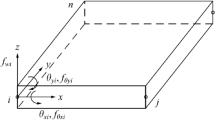Abstract
Identifying the place and dimensions of damage is among the most important ways to maintain the structure. It is possible to identify damage in structure by different damage identification methods or prevent damage expansion by necessary restorative measures and increase the structure's lifetime. This study has represented an efficient method to determine the location and severity of damage structures utilizing optimization time-domain responses. Used time-domain responses are node accelerations in limited points of a sheet under dynamic load obtained through the Newmark Method. First, the objective function is defined in optimization using damaged structure accelerations and analytical accelerations obtained from an analytical model. The damage identification problem, which has turned into an optimization problem, is solved by Grasshopper Optimization Algorithm to determine the structure's damage place and severity. To investigate the efficiency of the suggested method, a numerical method has been represented. The results demonstrate the recommended method’s high efficiency to determine the place and severity of the damage preciously considering measurement noise. Various structures suffer from burnout and failure after time. Different failures can be the sort of crack, corrosion, surrendering, and crushing. The type of failure depends on structure, application, environmental conditions, and structure material. For example, in steel bridges, corrosion of girders and sea platforms at the end of diagonal members is the most common deterioration. Identification, restoration, repair, or replacement of damaged members has always been one of the structural engineers’ goals. Therefore, the process of identifying damaged members is one of the most essential and necessary parts of the maintenance and restoration of structures.











Similar content being viewed by others
References
Arora S, Anand P (2019) Chaotic grasshopper optimization algorithm for global optimization. Neural Comput Appl 31(8):4385–4405
Beygzadeh S, Salajegheh E, Torkzadeh P, Salajegheh J, Naseralavi SS (2013) Optimal sensor placement for damage detection based on a new geometrical viewpoint. Iran Univ Sci Technol 3(1):1–21
Cawley P, Adams RD (1979) The location of defects in structures from measurements of natural frequencies. J Strain Anal Eng Design 14(2):49–57
Clough R, Penzien B (1975) Dynamics of structures. McGraw-Hill, New York
de Mello Junior HD, Marti L, da Cruz AVA, Vellasco MMR (2016) Evolutionary algorithms and elliptical copulas applied to continuous optimization problems. Inf Sci 369:419–440
Esfandiari A, Bakhtiari-Nejad F, Rahai A (2013) Theoretical and experimental structural damage diagnosis method using natural frequencies through an improved sensitivity equation. Int J Mech Sci 70:79–89
Fallahian S, Joghataie A, Kazemi MT (2018) Structural damage detection using time domain responses and teaching–learning-based optimization (TLBO) algorithm. Scientia Iranica 25(6):3088–3100
Farooq M, Zheng H, Nagabhushana A, Roy S, Burkett S, Barkey M, et al (2012) Damage detection and identification in smart structures using SVM and ANN. In: Smart sensor phenomena, technology, networks, and systems integration 2012, vol. 8346. International Society for Optics and Photonics, p 83461O
Fu YZ, Lu ZR, Liu JK (2013) Damage identification in plates using finite element model updating in time domain. J Sound Vib 332(26):7018–7032
Gerist S, Maheri MR (2019) Structural damage detection using imperialist competitive algorithm and damage function. Appl Soft Comput 77:1–23
Guo SS, Wang JS, Xie W, Guo MW, Zhu LF (2020) Improved grasshopper algorithm based on gravity search operator and pigeon colony landmark operator. IEEE Access 8:22203–22224
Ismail Z, Razak HA, Rahman AA (2006) Determination of damage location in RC beams using mode shape derivatives. Eng Struct 28(11):1566–1573
Jeyasehar CA, Sumangala K (2006) Damage assessment of prestressed concrete beams using artificial neural network (ANN) approach. Comput Struct 84(26–27):1709–1718
Kohler M, Vellasco MM, Tanscheit R (2019) PSO+: a new particle swarm optimization algorithm for constrained problems. Appl Soft Comput 85:105865
Liu YY, Ju YF, Duan CD, Zhao XF (2011) Structure damage diagnosis using neural network and feature fusion. Eng Appl Artif Intell 24(1):87–92
Logan D (2011) A first course in the finite element method. Cengage Learn. CL Engineering. 5th edn
Mahmoud MA, Kiefa MAA (1999) Neural network solution of the inverse vibration problem. NDT E Int 32(2):91–99
Mechanical (2013) A., ANSYS 13 Help system. [Electronic data and program]/ANSYS. Inc.—Canonsburg (PA)
Messina A, Williams E, Contursi T (1998) Structural damage detection by a sensitivity and statistical-based method. J Sound Vib 216(5):791–808
Niu Z (2020) Frequency response-based structural damage detection using Gibbs sampler. J Sound Vib 470:115160
Perera R, Fang SE (2010) Multi-objective damage identification using particle swarm optimization techniques. Multi-objective swarm intelligent systems. Springer, Berlin, pp 179–207
Precup RE, David RC, Petriu EM, Szedlak-Stinean AI, Bojan-Dragos CA (2016) Grey wolf optimizer-based approach to the tuning of PI-fuzzy controllers with a reduced process parametric sensitivity. IFAC-PapersOnLine 49(5):55–60
Precup RE, Hedrea EL, Roman RC, Petriu EM, Szedlak-Stinean AI, Bojan-Dragos CA (2020) Experiment-based approach to teach optimization techniques. IEEE Trans Educ 64(2):88–94
Saremi S, Mirjalili S, Lewis A (2017) Grasshopper optimisation algorithm: theory and application. Adv Eng Softw 105:30–47
West WM (1986) Illustration of the use of modal assurance criterion to detect structural changes in an orbiter test specimen. Conference paper, 19870041253
Zhang Z, Aktan AE (1995) The damage indices for the constructed facilities. In: Proceedings-spie the International Society for Optical Engineering. SPIE International Society for Optical, p 1520
Author information
Authors and Affiliations
Corresponding author
Additional information
Publisher's Note
Springer Nature remains neutral with regard to jurisdictional claims in published maps and institutional affiliations.
Electronic supplementary material
Below is the link to the electronic supplementary material.
Rights and permissions
About this article
Cite this article
Nabavi, S., Gholampour, S. & Haji, M.S. Damage detection in frame elements using Grasshopper Optimization Algorithm (GOA) and time-domain responses of the structure. Evolving Systems 13, 307–318 (2022). https://doi.org/10.1007/s12530-021-09389-y
Received:
Accepted:
Published:
Issue Date:
DOI: https://doi.org/10.1007/s12530-021-09389-y




